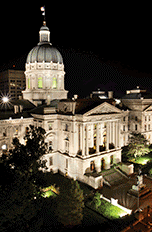 The “Small Business Tax Index 2017: Best to Worst State Tax Systems for Entrepreneurship and Small Business” ranks the 50 states according to the costs of their tax systems for entrepreneurship and small business.
The “Small Business Tax Index 2017: Best to Worst State Tax Systems for Entrepreneurship and Small Business” ranks the 50 states according to the costs of their tax systems for entrepreneurship and small business.
View an interactive U.S. map of “Small Business Tax Index 2017” results.
Raymond J. Keating, chief economist for the Small Business & Entrepreneurship (SBE) Council and author of the report, said: “While there is much discussion in Congress and the Trump administration about making the federal tax system more competitive, these issues obviously reach down to state and local levels as well. That’s the focus of SBE Council’s ‘Small Business Tax Index 2017.’ Specifically, which states are among the least burdensome in terms of taxes, and which inflict the weightiest burdens on small businesses?”
The SBE Council pulls together 26 different tax measures, and combines those into one tax score that allows the 50 states to be compared and ranked. Among the taxes included are income, capital gains, property, death, unemployment, and various consumption-based taxes, including state gas and diesel levies.
According to the “Small Business Tax Index 2017,” the 10 best state tax systems are: 1) Nevada, 2) Texas, 3) South Dakota, 4) Wyoming, 5) Washington, 6) Florida, 7) Alabama, 8) Ohio, 9) North Carolina, and 10) Colorado.
The bottom 10 include: 41) Connecticut, 42) Oregon, 43) New York, 44) Vermont, 45) Hawaii, 46) Iowa, 47) Minnesota, 48) Maine, 49) New Jersey, and 50) California.
Since last year’s report, several states have made significant tax changes.
Five states – Arizona, Indiana, New Hampshire, New Mexico, and North Carolina – have improved their tax climates by reducing their personal or corporate income tax rates. Other states – such as New Mexico and Tennessee – have scheduled changes that will improve their tax climates for entrepreneurship, business and investment in coming years. Unfortunately, all of the news is not good. Kansas, Maine and New York have made tax changes that are negatives.

 Last month the Indiana Chamber reported that a Colorado Supreme Court decision determined that “lawsuit lending” is a loan and will be regulated under the Uniform Consumer Credit Code (UCCC) in Colorado – and that it could impact what happens in the Indiana General Assembly. (Lawsuit lending is the practice of advancing money to a plaintiff/someone involved in an accident in anticipation of winning a lawsuit in court. If the plaintiff is awarded a settlement, the advance must be repaid at considerably high interest rates. If the plaintiff loses the suit, there is no obligation to repay the loan.)
Last month the Indiana Chamber reported that a Colorado Supreme Court decision determined that “lawsuit lending” is a loan and will be regulated under the Uniform Consumer Credit Code (UCCC) in Colorado – and that it could impact what happens in the Indiana General Assembly. (Lawsuit lending is the practice of advancing money to a plaintiff/someone involved in an accident in anticipation of winning a lawsuit in court. If the plaintiff is awarded a settlement, the advance must be repaid at considerably high interest rates. If the plaintiff loses the suit, there is no obligation to repay the loan.) As the 2016 legislative session nears, an interesting development occurred in Colorado over an issue that the Indiana Chamber has been working on for the last several years. This week, the Colorado Supreme Court determined that the practice of litigation finance, or more commonly referred to as “lawsuit lending”, was determined to be a loan and subject to Colorado’s Uniform Consumer Credit Code (UCCC).
As the 2016 legislative session nears, an interesting development occurred in Colorado over an issue that the Indiana Chamber has been working on for the last several years. This week, the Colorado Supreme Court determined that the practice of litigation finance, or more commonly referred to as “lawsuit lending”, was determined to be a loan and subject to Colorado’s Uniform Consumer Credit Code (UCCC). Reactions were varied recently when the company operating the Indiana Toll Road filed for bankruptcy. A researcher at the Harvard Kennedy School emphasizes the positive aspects of how that deal was structured and focuses on the continually evolving role of each party in such an agreement.
Reactions were varied recently when the company operating the Indiana Toll Road filed for bankruptcy. A researcher at the Harvard Kennedy School emphasizes the positive aspects of how that deal was structured and focuses on the continually evolving role of each party in such an agreement.  I'll risk showing my age by asking how many remember the advertising phrase: "How many licks does it take to get to the Tootsie Roll center of a Tootsie Pop?" The ads on U.S. television go back to 1970.
I'll risk showing my age by asking how many remember the advertising phrase: "How many licks does it take to get to the Tootsie Roll center of a Tootsie Pop?" The ads on U.S. television go back to 1970.
 Combined television advertising spending in the presidential race is on pace to top $1 billion by Election Day. And while you might think you’re seeing more than a few attacks and the occasional "I have an idea" spot here in Hoosierland, we’re actually barely a blip on the radar screen.
Combined television advertising spending in the presidential race is on pace to top $1 billion by Election Day. And while you might think you’re seeing more than a few attacks and the occasional "I have an idea" spot here in Hoosierland, we’re actually barely a blip on the radar screen. Indiana is home to seven of the 214 U.S. bicycle-friendly communities, according to the League of American Bicyclists. There are only three communities in the platinum grouping. In Indiana, Bloomington is a silver designee, with the following in the large bronze category: Carmel, Columbus, Fort Wayne, Goshen, Indianapolis and South Bend.
Indiana is home to seven of the 214 U.S. bicycle-friendly communities, according to the League of American Bicyclists. There are only three communities in the platinum grouping. In Indiana, Bloomington is a silver designee, with the following in the large bronze category: Carmel, Columbus, Fort Wayne, Goshen, Indianapolis and South Bend.  Random info about Wyoming and women (I told you it was random) found in the State Legislatures magazine:
Random info about Wyoming and women (I told you it was random) found in the State Legislatures magazine: When you read as many reports, studies, analyses and similar materials as I do, it’s difficult to be shocked by many of the facts that emerge. But check out these numbers from the Pew Center on the States regarding voter registration:
When you read as many reports, studies, analyses and similar materials as I do, it’s difficult to be shocked by many of the facts that emerge. But check out these numbers from the Pew Center on the States regarding voter registration: